 Web Content Display
Web Content Display

Starry Sky of the Four Seasons
Tab Menu
 Web Content Display
Web Content Display
Although the starry sky in spring is not very spectacular, it has the largest and the smallest constellations. On a spring night in Hong Kong, you can find the 3 largest constellations in the sky, i.e. Hydra, Virgo and Ursa Major. The total area of these three constellations is nearly 10% of that of the observable sky (there are altogether 88 constellations in the sky)! Quite a number of people think that Crux, which has the smallest area, can only be observed in countries such as New Zealand, Australia and Brazil in the southern hemisphere. In fact, in places with low latitudes in the northern hemisphere including Hong Kong, we can observe it in spring. However, you have to go to a place without obstruction in the south near the horizon, such as southern Lantau or even Yuen Long to have a chance to observe Crux.

Making use of Big Dipper to find the North Pole
In ancient times when there was no internet, explorers sailing to faraway places made use of Polaris in the night sky for positioning and identifying the direction. Polaris is very close to the north pointed by the axis of rotation of the Earth and it seems motionless hanging in the sky. Even though other stars change positions in different seasons, the correct direction can be located by finding Polaris. There being not any bright star in Polaris and in Ursa Minor where it is located, we need other constellations to guide us in finding its location. In places at a higher latitude in the northern hemisphere, we can make use of the Big Dipper at the tail of Ursa Major, which hangs in the sky all year round, to locate Polaris.
The Big Dipper is like a giant spoon hanging in the sky. From "bowl" to "handle", Big Dipper is consisting of seven bright stars called "Dubhe", "Merak", "Phecda", "Megrez", "Alioth", "Mizar" and "Alkaid" respectively. Polaris is found by imagining a line from Merak to Dubhe and extend it for five times in the same direction.
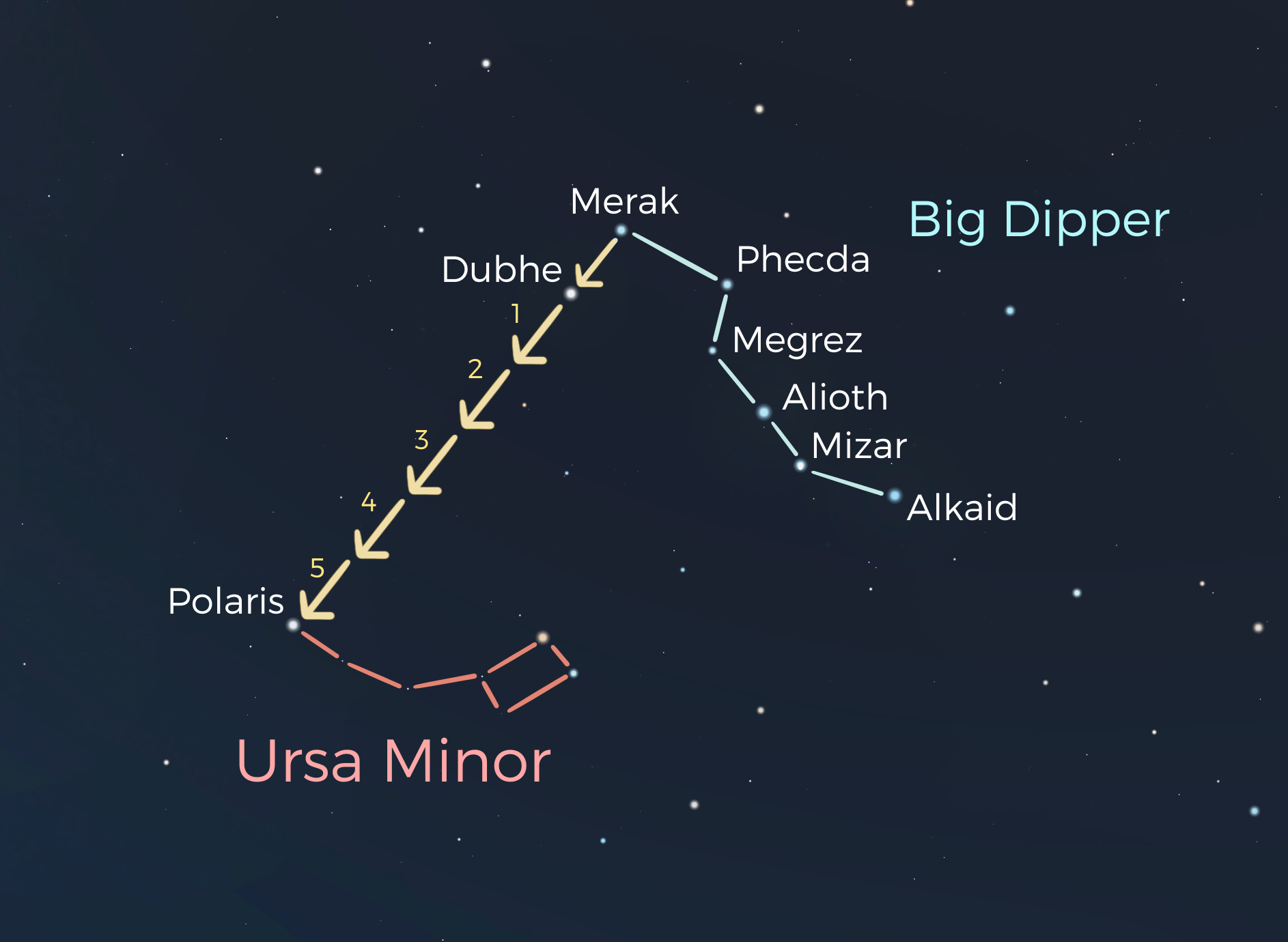
Spring Curve
There are several particularly bright stars in the starry sky in spring. Not only can they be easily identified but when linked up, they can form a big curve in the night sky. The bright stars that form the Spring Curve start from the three bright stars in the handle of the Big Dipper at the tail of Ursa Major (Alioth, Mizar and Alkaid) and stretch to Arcturus in Bootes and Spica in Virgo, and finally end at the quadrilateral Corvus.

Spring Triangle and Great Diamond
Apart from the Spring Curve, another highlight of the starry sky in spring is the Spring Triangle, which comprises Arcturus in Bootes, Spica in Virgo and Denebola in Leo. Located at the tail of Leo, Denebola is also the second brightest star in Leo. Regulus is the brightest star in Leo and is considered the Leo's heart. Part of Leo looks like an inverted question mark in the night sky with Regulus as the dot in the question mark. As Regulus is the nearest bright star to the Ecliptic, occultation of Regulus by the Moon frequently occurs and sometimes it is even obscured by a planet or an asteroid.
By adding Cor Caroli in Canes Venatici to the Spring Triangle, the Great Diamond is formed.
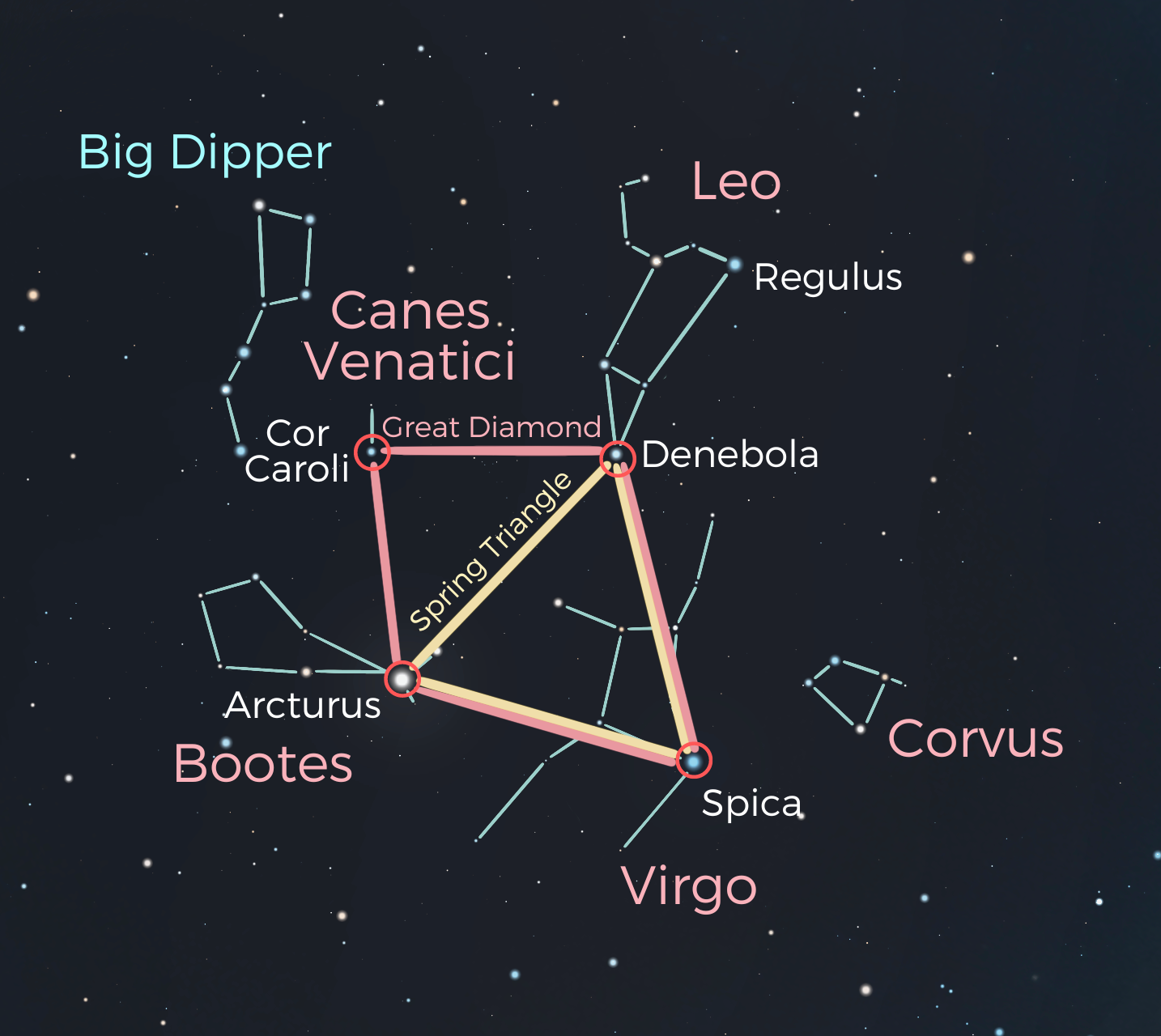
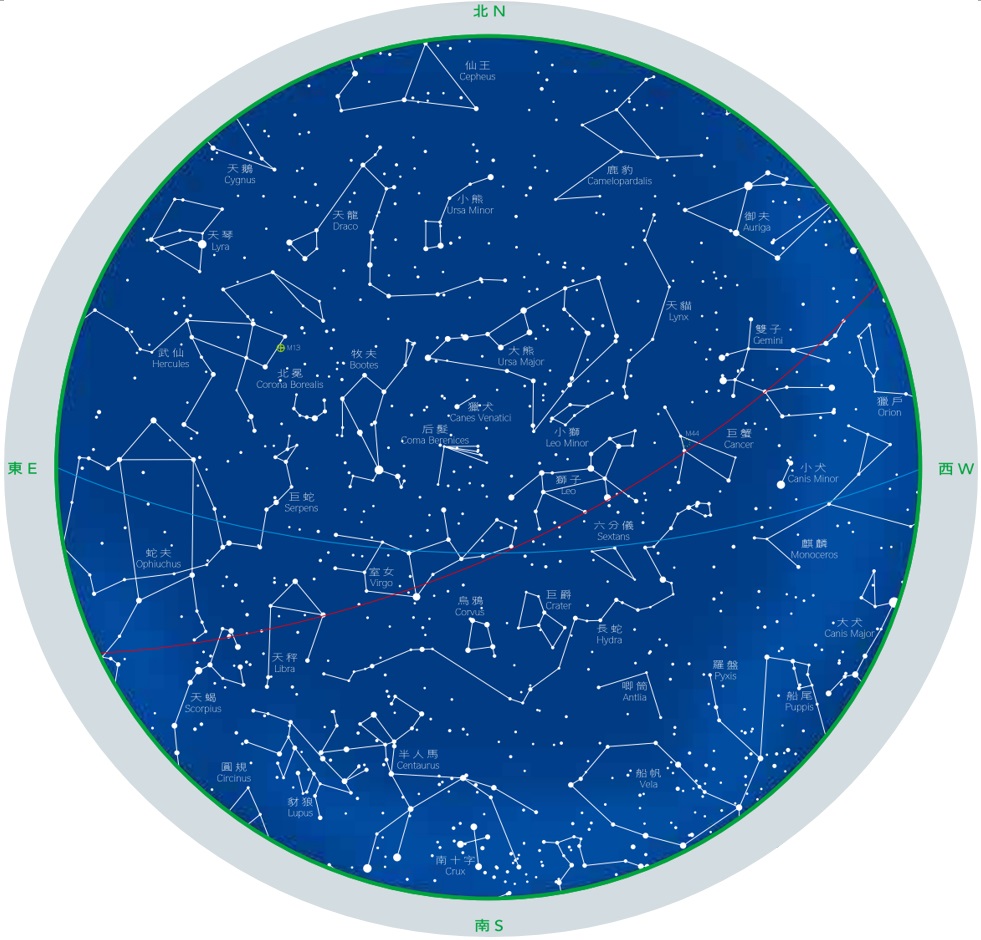
| Works Best at | |
| Date | Time |
| 1 April | 00:00 |
| 1 May | 22:00 |
| 1 June | 20:00 |
Apart from Leo and Virgo, Cancer, Gemini, Hercules, Centaurus and Hyda are the constellations that appear in spring. Besides, Hyda is the largest of the 88 constellations.
 Web Content Display
Web Content Display
Before introducing the bright stars and constellations in summer, the Milky Way in summer is also one of the major wonder of the summer starry sky. Summer is the season most suitable for observing the Milky Way. Not only can we observe the brightest part of the centre of the Milky Way, but we can also observe the Milky Way in the night sky with the longest duration when compared with other seasons. Even in Hong Kong, which is well-lit all year round, when we go to the countryside, we shall be able to observe the splendid Milky Way provided that the weather is fine.

Photo taken at the Astropark in Sai Kung , Image Credit:Mew Chu
Summer Triangle
There are more bright stars in summer than in spring and they are brighter too. Perhaps you may not have heard of the Summer Triangle but you must have heard about the romantic legend of "the Cowherd and the Weaving Maid". Legend has it that the Cowherd and the Weaving Maid are permitted to meet each other only on the seventh evening of the seventh moon each year on the bridge formed by magpies across the Milky Way. In the summer night sky, you can find Altair and Vega on the east side and the west side of the Milky Way and they are the brightest stars in Aquila and Lyra respectively. Altair, Vega together with Deneb in Cygnus, which is located at the Milky Way form the Summer Triangle. As the pattern of Cygnus resembles a huge cross, it is also known as "the Northern Cross".
Heart of the Scorpion and the Teapot with Rising Steam
Near the centre of the Milky Way is a reddish bright star, Antares, the brightest main star of Scorpius. It is also known as "Huge Fire". Scorpius can be counted as the most recognizable constellation in the summer starry sky. It is made up of stars that form the English letter "J". The tail of "J" resembles the curving tail of a scorpion whereas the reddish Antares, located at the upper half of the body of the scorpion, seems like its "heart".
Apart from Scorpius, another constellation appearing in summer is the well-known Sagittarius. Several stars of it form the shape of a teapot. As it is located at the centre of the Milky Way, at a glance, the Milky Way seems like a puff of steam rising from the spout of the teapot.


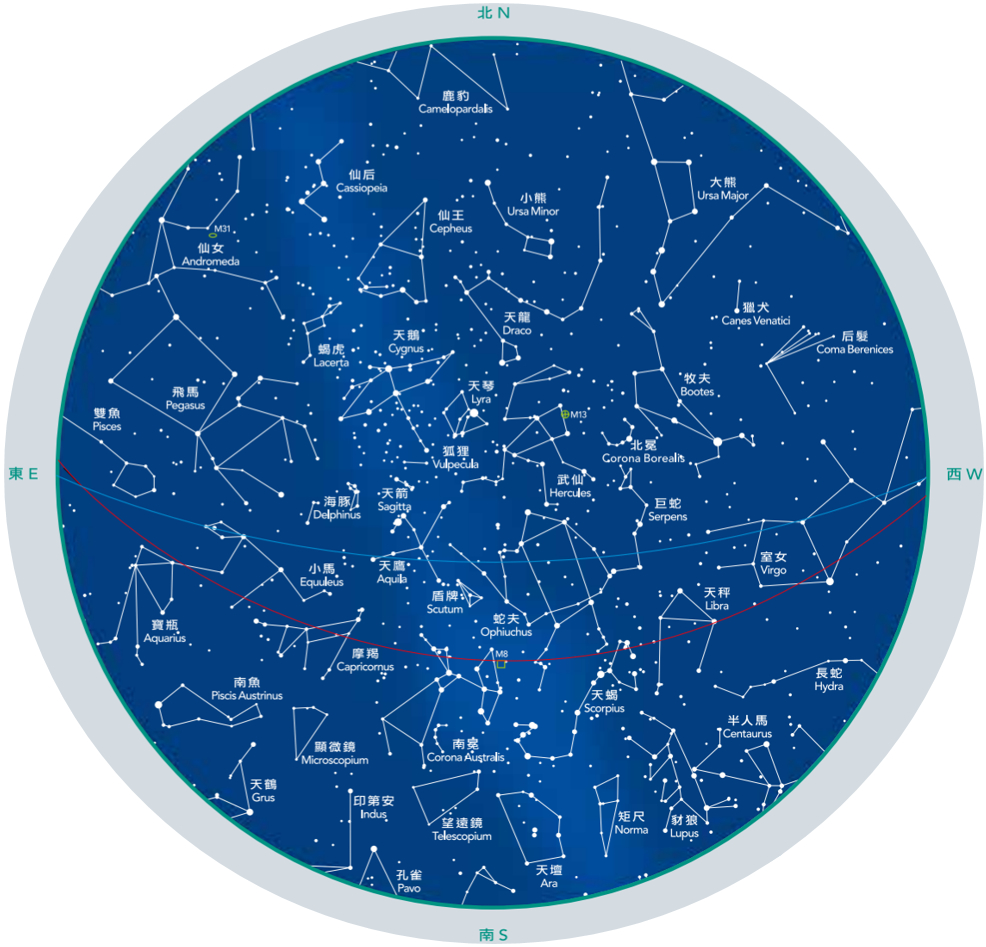
| Works Best at | |
| Date | Time |
| 1 July | 00:00 |
| 1 August | 22:00 |
| 1 September | 20:00 |
 Web Content Display
Web Content Display
Autumn is the season that has the least number of bright stars. Yet the roles and backgrounds of those stars that appear are well-known in ancient mythology. Members of "the constellations of the Royal Family" include Cepheus, Cassiopeia, Andromeda and Perseus. With the autumn night sky as the background, Cepheus is like a knight on a winged horse (Pegasus), rescuing the princess from the sea monster (Cetus). He succeeded in doing so and married the princess as well, weaving a fairy tale of "a hero saving a damsel in distress".
Besides, Andromeda is also where we can find a large galaxy nearest to us. Moreover, one of the stars of Cepheus is the first variable star (Cepheid variable) discovered by astronomers and its luminosity varies periodically. Algol, also known as the "Demon Star", is a bright star in Perseus. Thanks to "the constellations of the Royal Family", the sombre starry sky in autumn becomes worthy of observation and study.
Making use of Cassiopeia to find the North Pole
For places with a low latitude such as Hong Kong, sometimes the tail of Ursa Major will be below the horizon. Hence, we have to make use of another more recognizable constellation, Cassiopeia, to locate Polaris. The stars that form Cassiopeia appear like the English letter "W". Extend the lines on the left and right of "W" until they intersect. By linking the intersection point with the star in the middle of "W" and extending the distance by 5 times, there you find the whereabouts of Polaris.

Andromeda Galaxy, which seems to be near to us and yet so far away
Andromeda Galaxy, a large galaxy which is closest to our Milky Way, is designated M31 in the Messier Catalogue*. Hence, it is generally known as M31 Andromeda Galaxy. Despite being the nearest galaxy to us, it is still 2.5 million light years away from the Earth (i.e. approximately 23,651,826,181,450,100,000 km!). Astronomers estimate that M31 Andromeda Galaxy has a diameter of 200,000 light years. Owing to its huge size, under fine weather conditions in autumn and winter, it is faintly visible by the naked eye. Although it looks like a hazy patch, it is already one of the farthest deep-sky objects that is visible to the naked eye.
*Messier was a French astronomer who compiled a catalogue of 110 astronomical objects, including nebulae, star clusters and galaxies during the period from 17th C to early 18th C. The catalogue came to be known as the Messier Catalogue.



| Works Best at | |
| Date | Time |
| 1 October | 00:00 |
| 1 November | 22:00 |
| 1 December | 20:00 |
In spring and summer, we can observe the astronomical phenomenon of the "Triangle" whereas in autumn, we can observe the "Autumn Square", which consists of 3 bright stars of Pegasus and 1 bright star of Andromeda. In the autumn starry sky, there is also a bright star "Fomalhaut" of Piscis Austrinus which appears in the south. The Hubble Space Telescope has captured images of "Fomalhaut b", a planet of "Fomalhaut". It is the first exoplanet that can be observed by visible light directly. Other constellations that can be observed in the autumn night sky include Aquarius, Pisces and Capricornus.
 Web Content Display
Web Content Display
Finally comes the starry sky in winter, which of course will not disappoint us. The starry sky in winter has the largest number of bright stars, each of them being so dazzling. Full of bright stars, star clusters and nebulae, the starry sky in winter becomes all the more brilliant.
Orion, King of Constellations
The most instantly recognisable constellation in the starry sky of the four seasons must be Orion. It is also known as "the king of constellations" and "the Winter Constellation". With its luminous stars, even amateurs can easily identify it. The brightest star is the bluish-white Rigel, and the second brightest star is Betelgeuse which is a red supergiant star.Three stars form a horizontal line representing the belt of Orion. Below the belt is one of the most famous deep sky objects, M42 Orion Nebula.
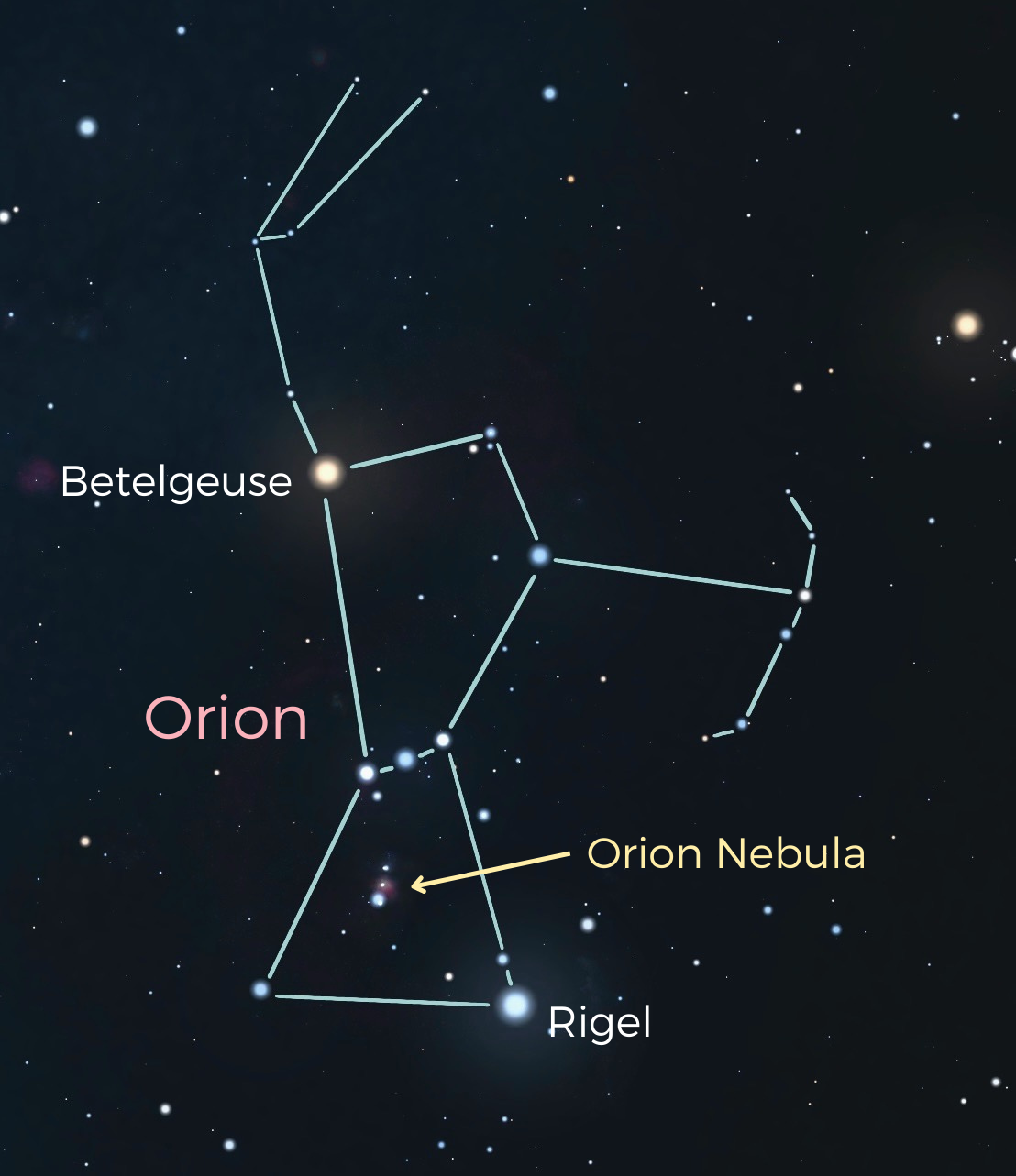
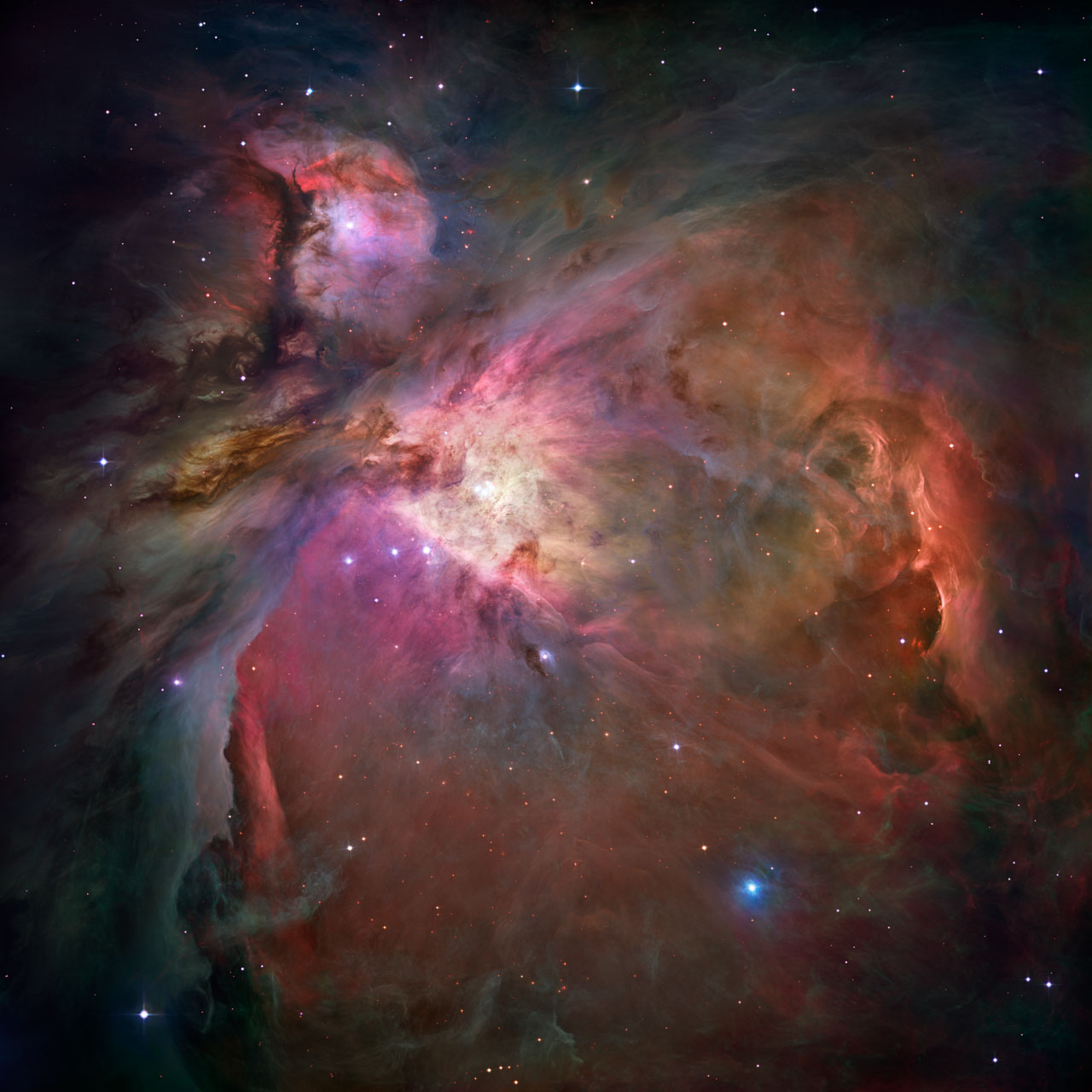
Notorious Sirius
Sirius, the brightest star of Canis Major, is also the brightest star in the entire night sky. It is only about 8.6 light years from the Earth. In ancient times, quite a number of countries considered it an ominous star. In ancient Egypt, people thought that the rising of Sirius before the sunrise signify the imminent flooding of the Nile whereas ancient Greeks considered intense twinkling of Sirius as a sign that something bad would happen.
The Zeus turned Taurus
In mythology, Zeus, the King of Gods turned himself into Taurus. In the starry sky, Taurus seems to be blessed by the Heavenly God to have many bright stars, of which the most luminous one is Aldebaran (Taurusα), orange red in colour, with an apparent magnitude of 0.86, representing the eye of the "bull". The Hyades is a loose star cluster which is located at the face of the "bull". It is also the nearest star cluster to us. M45 The Pleiades, also known as The Seven Sisters, is a very luminous star cluster. Not only can it be easily seen by the naked eye, but it also form the shape of a question mark when observed through binoculars.
Winter Triangle and Winter Circle
The Winter Triangle, found in the Winter Circle, is an almost equilateral triangle composed of Sirius in Canis Major, Procyon in Canis Minor and Betelgeuse in Orion. As the three stars are nearly of the same brightness, they can be easily recognised in the night sky. After finding the Winter Triangle, look further and you can see the Winter Circle. The Winter Circle, also known as the Winter Hexagon, is made up of Rigel in Orion, Sirius in Canis Major, Procyon in Canis Minor, Pollux in Gemini, Capella in Auriga and Aldebaran in Taurus. You can spot this hexagon even in a brilliantly illuminated city. Next time, gaze at the sky in winter and you will have amazing discovery.
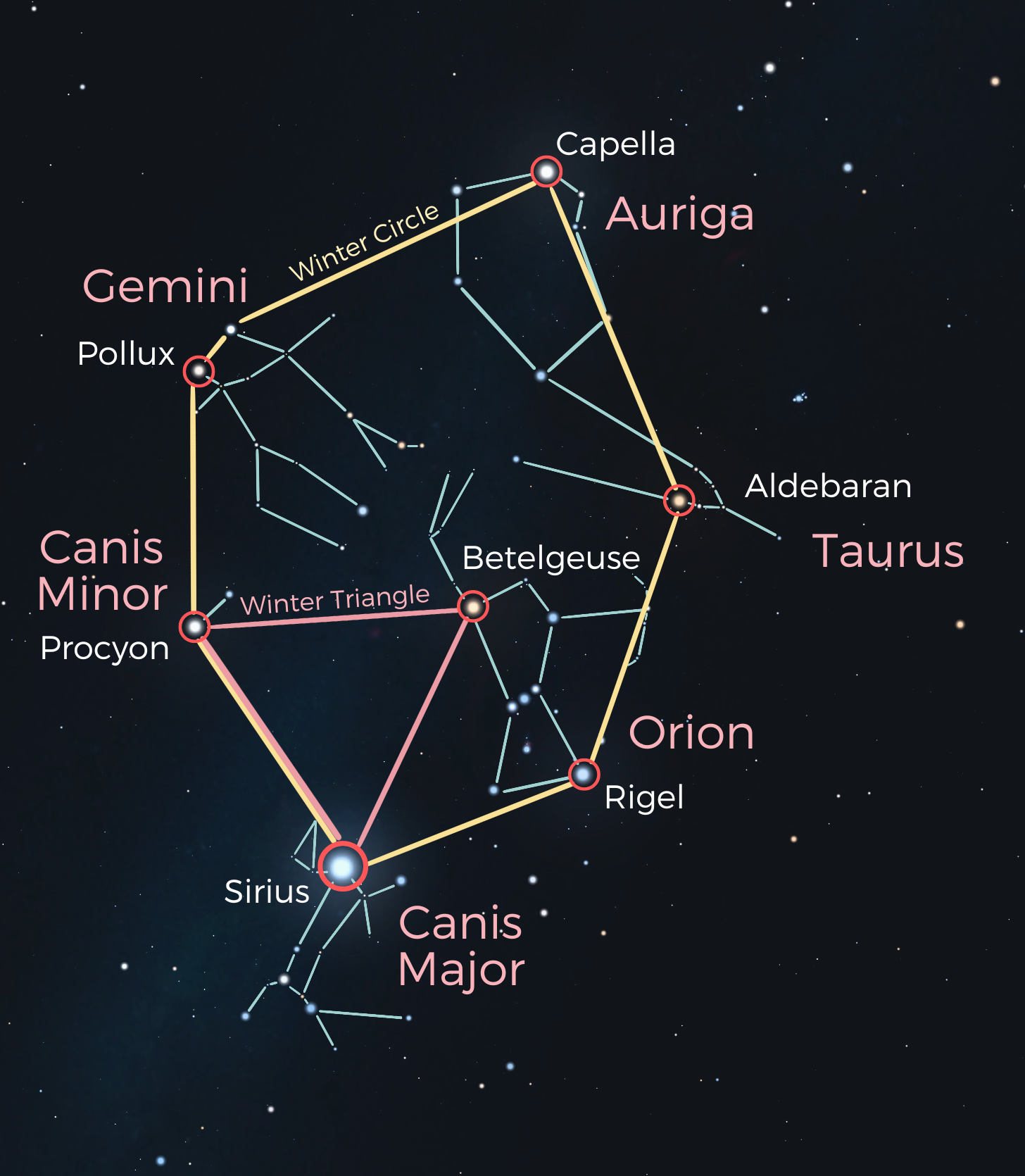

| Works Best at | |
| Date | Time |
| 1 January | 00:00 |
| 1 February | 22:00 |
| 1 March | 20:00 |
